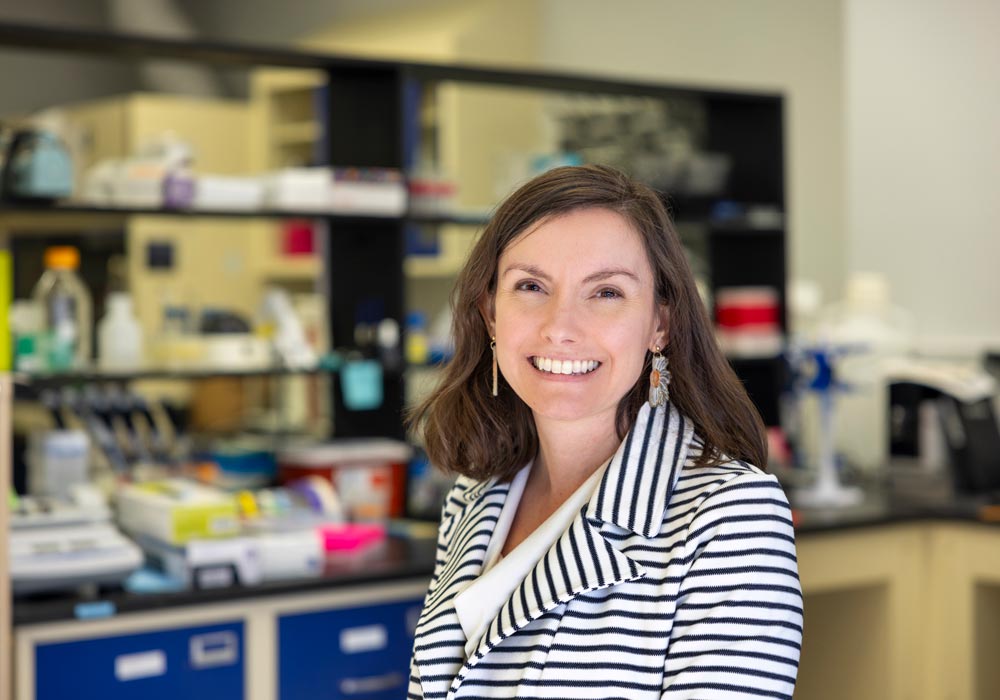Scientists at the University of South Carolina School of Medicine Columbia are researching important linkages between brain mitochondrial function and social behavior that could lead to a better understanding of autism spectrum disorder and post-partum depression.
Fiona Hollis, an assistant professor in the Department of Pharmacology, Physiology and Neuroscience, says her research is fundamental but has important clinical implications.
“We’re focused on the neurological underpinnings of social behavior and what happens when social behaviors are disrupted,” Hollis says. “We believe that brain mitochondrial function sits at the heart of that.”
Mitochondria organelles generate biochemical energy necessary for cellular function and play a vital role in immune activation, cell signaling and hormone synthesis, among other functions. Chronic stress can reveal the links between mitochondrial function and social behavior.
“Our research studies how brain mitochondrial function might modulate social behavior,” she says. “We do this by examining the impacts of chronic stress at different critical periods across the lifespan and then looking at how chronic stress affects brain mitochondrial function in relation to behaviors that are relevant for different neuropsychiatric disorders or neurodevelopmental disorders.”
Hollis’ team uses specialized rodent models to explore how reduction and enhancement of mitochondrial function affects social behavior. In general, reducing mitochondrial function leads to social behaviors in rodents that mimic behaviors seen in humans on the autism spectrum.
“Mitochondrial dysfunction is not a core symptom of autism, but it's certainly on the radar in the clinic.”
For example, rodents typically are highly social animals, but if their mitochondrial respiration is temporarily reduced, they tend to prefer spending time with an inanimate object instead of another rodent, Hollis says. Such behavior parallels that of autistic children who often avoid social interaction with other children.
“When you look at the scientific literature on autism, there's a large number of case control studies where evidence of mitochondrial dysfunction is present in these patients, and it's at a higher rate than you would find in the average population,” Hollis says. “Mitochondrial dysfunction is not a core symptom of autism, but it's certainly on the radar in the clinic.”
Hollis’ team is also trying to uncover male and female differences in the chronic stress-mitochondrial function-social behavior dynamic. So far they have found that chronic stress affects mitochondrial respiration in different brain regions between males and females. Their current goal is to establish how these differences might lead to different social behavioral responses to stress.
Hollis is an affiliate of the university’s Carolina Autism and Neurodevelopment Research Center, collaborating with clinicians from psychology and communication sciences and disorders. “CAN Center clinicians are trying to identify autism spectrum disorders in infants as young as possible who might be on the autism spectrum, and that kind of spurred us to look at neonatal-stage offspring in our rodent models,” Hollis said. “We’re hoping to identify potential biomarkers that would be useful for their clinical research.”
In addition to collaborating with other CAN Center researchers, Hollis is involved with a project at the School of Medicine’s Institute for Cardiovascular Disease Research focused on the effects of chronic stress on the brain in relation to cardiovascular disease. She also recently received approval for a Veterans Administration research grant that will study gestational stress and postpartum depression, which disproportionately affects female veterans.
Hollis joined the School of Medicine Columbia faculty in 2020 after earning a Ph.D. from Florida State University’s College of Medicine and completing postdoctoral fellowships in Switzerland, where she began focusing on brain mitochondrial function.
